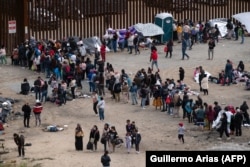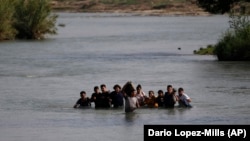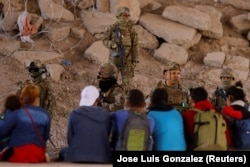Saodat Jumaboeva and her family of three are flying to Istanbul this week in the first leg of a journey to what the Tajik migrants hope will be a new, better life in the United States.
The Jumaboevs have been planning their trip for months along with five others -- a fellow Tajik and four Kyrgyz -- whom they befriended in Moscow, where the Central Asians currently live and work.
None of them has a U.S. visa, and they are not planning to apply for one.
Instead, the friends are joining a rapidly growing mass of Central Asian and Russian asylum seekers who are trying to enter the United States illegally from Mexico to pursue their American dreams.
"We know many Kyrgyz and Uzbeks who went to Mexico last year, using their Russian passports, and they are already in America, working there, making money," Jumaboeva told RFE/RL on May 17. "We will take our chances, too."
The Jumaboevs are not deterred by the prospect of the potentially perilous journey through Mexico that -- according to some witnesses -- might entail being robbed, assaulted, imprisoned, or even dying along the way.
They are also not dissuaded by new, tougher U.S. immigration regulations that might potentially disqualify them from seeking asylum in the United States.
Under the new regulations enforced this month, migrants can be turned away at the border if they didn't apply for asylum online before trying to enter the country or didn't first seek asylum in any of the other countries they traveled through en route to the United States.
Those who cross into the United States illegally could be deported and face a five-year ban from the country.
The Jumaboevs and their friends are all naturalized Russian citizens. The group will be traveling with their Russian passports to take advantage of visa-free entry for Russian nationals to Mexico.
Official statistics show a substantial uptick in the number of Russian passport holders entering the United States through Mexico since early 2022. Many link the trend to Moscow's invasion of Ukraine, an event that prompted thousands to flee Russia.
According to U.S. Customs and Border Protection figures, 36,271 Russian nationals sought entry through the southern borders of the United States in the 2022 fiscal year (starting on October 1, 2021), compared to 13,240 people in the previous year.
The trend continues to grow with 38,259 arrivals between October 2022 and March 2023.
U.S. government figures also show higher rates of approval for asylum applications from Uzbek, Kazakh, and Russian nationals between October and January.
Entering Via Nicaragua
According to Kyrgyz media reports, most of the Kyrgyz nationals who crossed into the United States from Mexico also carried Russian passports.
But those who don't have a second passport explore other routes through Central and South America.
Some Kazakh nationals first land in Brazil, a country that allows them to enter visa-free.
Kyrgyz and Uzbeks are increasingly choosing Nicaragua as their point of entry to the continent before moving toward Mexico.
Speaking on condition of anonymity, a Kyrgyz man said there were about 30 Kyrgyz citizens aboard the Istanbul-Managua flight he took in early May.
He told RFE/RL's Kyrgyz Service that all of his compatriots were traveling with the sole intention of eventually making it to the United States.
The group paid money to people smugglers who drove them from Nicaragua through Honduras and Guatemala to the southern Mexican city of Tapachula, he said.
The man said the majority of the occupants of the six-story Tapachula hotel he was staying in were Kyrgyz citizens, filling up about 90 of the building's 120 rooms, with four or five people staying in each room. There are also Uzbeks and other Central Asians, albeit in smaller numbers, he said.
Most of the migrants had applied online for U.S. asylum ahead of their northbound journey to the United States.
While Russia is still the largest recipient of Central Asian migrants, thousands of people from the five former Soviet republics in the region have arrived in the United States in recent years, using both legitimate and illegal routes.
'Asylum Case'
In Moscow, the Jumaboevs sold their car, left their rented home, and set aside money "both in cash and cards" to finance their journey.
Based on the advice of their acquaintances whom they said are "already in Chicago" after leaving Russia last year, the Jumaboevs expect they will need about $15,000 per person to reach their destination if everything goes according to plan.
The Jumaboevs and the others -- all in their early 30s -- have also thought about their asylum cases.
The Tajik man, who hails from the restive Gorno-Badakhshan region, will apply for protection on the basis of the persecution of ethnic groups, Jumaboeva said.
"He has a stronger case than the rest of us," she said. "My husband and our Kyrgyz friends [are] fleeing military mobilization in Russia."
While the prospect of a Central Asian migrant with a Russian passport being sent to the war in Ukraine is real, Jumaboeva admits going to America is mostly about "better economic opportunities and a better life."
A gynecologic nurse by training, Jumaboeva wants to start as a babysitter or caregiver for the elderly in America but dreams of eventually finding a better-paid job at a maternity hospital.
Her husband, a veterinarian, works as a taxi driver in Moscow. In the United States he wants to become a truck driver, a job that employs many Central Asian male migrants.
Asked about the latest U.S. immigration regulations, which could make them ineligible for asylum, Jumaboeva said: "It just proves that we need to get there before America tightens the screws even more."
"I regret we didn't leave right after the [Ukraine] war started," she said. "Our friends in Chicago said we should get in soon, because [former U.S. President Donald] Trump might win the next election and shut the U.S. doors on migrants' faces altogether."












